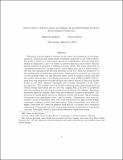| dc.contributor.author | Bokhari, Sheharyar | |
| dc.contributor.author | Geltner, David M | |
| dc.date.accessioned | 2019-01-31T14:27:49Z | |
| dc.date.available | 2019-01-31T14:27:49Z | |
| dc.date.issued | 2016-05 | |
| dc.identifier.issn | 1080-8620 | |
| dc.identifier.issn | 1540-6229 | |
| dc.identifier.uri | http://hdl.handle.net/1721.1/120153 | |
| dc.description.abstract | This article reports empirical evidence on the nature and magnitude of real depreciation in commercial and multifamily investment properties in the United States. The article is based on a much larger and more comprehensive database than prior studies of depreciation in such properties, and it is based on actual transaction prices rather than appraisal estimates of property or building structure values. The article puts forth an "investment perspective" on depreciation, which differs from the tax policy perspective that has dominated the previous literature in the United States. From the perspective of the fundamentals of investment performance, depreciation is measured as a fraction of total property value, not just structure value, and it is oriented toward cash flow and market value metrics of investment performance such as internal rate of return and holding period return. Depreciation from this perspective includes all three age-related sources of long-term secular decline in real value: physical, functional and economic obsolescence of the building structure. The analysis based on 107,805 transaction price observations finds an overall average depreciation rate of 1.5%/year, ranging from 1.82%/year for properties with new buildings to 1.12%/year for properties with 50-year-old buildings. Apartment properties depreciate slightly faster than nonresidential commercial properties. Depreciation is caused almost entirely by decline in the property's current real income, only secondarily by increase in the capitalization rate ("cap rate creep"). Depreciation rates vary considerably across metropolitan areas, with areas characterized by space market supply constraints exhibiting notably less depreciation. This is particularly true when the supply constraints are caused by physical land scarcity as distinct from regulatory constraints. Commercial real estate asset market pricing, as indicated by transaction cap rates, is importantly related to depreciation differences across metro areas. | en_US |
| dc.publisher | Wiley Blackwell | en_US |
| dc.relation.isversionof | http://dx.doi.org/10.1111/1540-6229.12156 | en_US |
| dc.rights | Creative Commons Attribution-Noncommercial-Share Alike | en_US |
| dc.rights.uri | http://creativecommons.org/licenses/by-nc-sa/4.0/ | en_US |
| dc.source | MIT web domain | en_US |
| dc.title | Characteristics of Depreciation in Commercial and Multifamily Property: An Investment Perspective | en_US |
| dc.type | Article | en_US |
| dc.identifier.citation | Bokhari, Sheharyar, and David Geltner. “Characteristics of Depreciation in Commercial and Multifamily Property: An Investment Perspective.” Real Estate Economics 46, 4 (May 2016): 745–782 © 2016 American Real Estate and Urban Economics Association | en_US |
| dc.contributor.department | Massachusetts Institute of Technology. Center for Real Estate | en_US |
| dc.contributor.department | Massachusetts Institute of Technology. Department of Urban Studies and Planning | en_US |
| dc.contributor.mitauthor | Bokhari, Sheharyar | |
| dc.contributor.mitauthor | Geltner, David M | |
| dc.relation.journal | Real Estate Economics | en_US |
| dc.eprint.version | Original manuscript | en_US |
| dc.type.uri | http://purl.org/eprint/type/JournalArticle | en_US |
| eprint.status | http://purl.org/eprint/status/NonPeerReviewed | en_US |
| dc.date.updated | 2019-01-18T19:13:53Z | |
| dspace.orderedauthors | Bokhari, Sheharyar; Geltner, David | en_US |
| dspace.embargo.terms | N | en_US |
| dc.identifier.orcid | https://orcid.org/0000-0002-1024-7555 | |
| mit.license | OPEN_ACCESS_POLICY | en_US |
